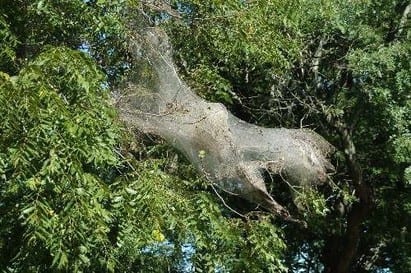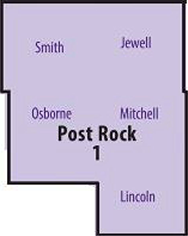 Fall webworm feeds on almost all fruit, shade, and ornamental trees except conifers. This insect is present more often on trees that are not surrounded by other trees. The larvae begin by constructing small webs near the ends of branches. The insect will gradually increase the size of the web as the need for food increases.
Fall webworm feeds on almost all fruit, shade, and ornamental trees except conifers. This insect is present more often on trees that are not surrounded by other trees. The larvae begin by constructing small webs near the ends of branches. The insect will gradually increase the size of the web as the need for food increases.
Mature caterpillars are yellowish with black and brown markings, and have many tufts of long hair. As larvae mature, they crawl down the tree and spend the winter as pupa in the leaf litter under the tree.
High populations of fall webworm can completely defoliate host plants but do not kill them. However, on pecan trees, nut production and quality can be reduced if webworms are not controlled. On ornamental plants, control is optional.
Pruning and destroying the infested portions of branches is a common control practice while webs are still small. A stick or pole with a nail inserted crosswise can be used to snag individual webs. Twisting the pole after insertion will cause the web to wrap around the pole where it can be removed and destroyed. Instead of a nail inserted crosswise, some people use a toilet brush attached to the end of a pole. Insecticides can also be used for control but a commercial quality, high-pressure sprayer is needed to penetrate the webs. Numerous products can be used for control including spinosad (Conserve; Fertilome Borer, Bagworm, Leafminer and Tent Caterpillar Spray; Captain Jack’s Dead Bug Brew), cyfluthrin (Tempo, Bayer Vegetable & Garden Insect Spray) and permethrin (numerous trade names). We normally consider fall webworm damage to be purely aesthetic, and control is not needed to protect the health of the tree.
By: Cassie Homan
 Fall webworm feeds on almost all fruit, shade, and ornamental trees except conifers. This insect is present more often on trees that are not surrounded by other trees. The larvae begin by constructing small webs near the ends of branches. The insect will gradually increase the size of the web as the need for food increases.
Fall webworm feeds on almost all fruit, shade, and ornamental trees except conifers. This insect is present more often on trees that are not surrounded by other trees. The larvae begin by constructing small webs near the ends of branches. The insect will gradually increase the size of the web as the need for food increases. Slime molds are common on turf and mulch and sometimes on tree trunks. Slime molds are not fungi and are no longer classified as such. They belong to the Kingdom Protista rather than Kingdom Fungi. On turf, you might see large numbers of small gray, white or purple fruiting structures, called sporangia on leaf blades during cool and humid weather throughout spring, summer, and fall. Affected areas are often several inches to 1 foot in diameter. During wet weather, the fruiting structures may appear slimy. As the structures dry out in hot weather, they become ash gray and break up easily when touched.
Slime molds are common on turf and mulch and sometimes on tree trunks. Slime molds are not fungi and are no longer classified as such. They belong to the Kingdom Protista rather than Kingdom Fungi. On turf, you might see large numbers of small gray, white or purple fruiting structures, called sporangia on leaf blades during cool and humid weather throughout spring, summer, and fall. Affected areas are often several inches to 1 foot in diameter. During wet weather, the fruiting structures may appear slimy. As the structures dry out in hot weather, they become ash gray and break up easily when touched. Slime molds on mulch often attract attention because of their bright colors and disgusting appearance. Common names are often quite descriptive. For example, the “dog vomit” slime mold is a bright, whitish color that resembles its namesake. It eventually turns brown and then into a hard, white mass. Slime molds do not hurt anything, but most people do not find them attractive and want to get rid of them. Simply use a shovel to discard the offensive organism and then stir up the mulch for aeration.
Slime molds on mulch often attract attention because of their bright colors and disgusting appearance. Common names are often quite descriptive. For example, the “dog vomit” slime mold is a bright, whitish color that resembles its namesake. It eventually turns brown and then into a hard, white mass. Slime molds do not hurt anything, but most people do not find them attractive and want to get rid of them. Simply use a shovel to discard the offensive organism and then stir up the mulch for aeration. We have been lucky this year with beautiful fall days and above normal temperatures. However, the forecast for the next few weeks shows temperatures dropping and we could possibly be facing snow or ice.
We have been lucky this year with beautiful fall days and above normal temperatures. However, the forecast for the next few weeks shows temperatures dropping and we could possibly be facing snow or ice.